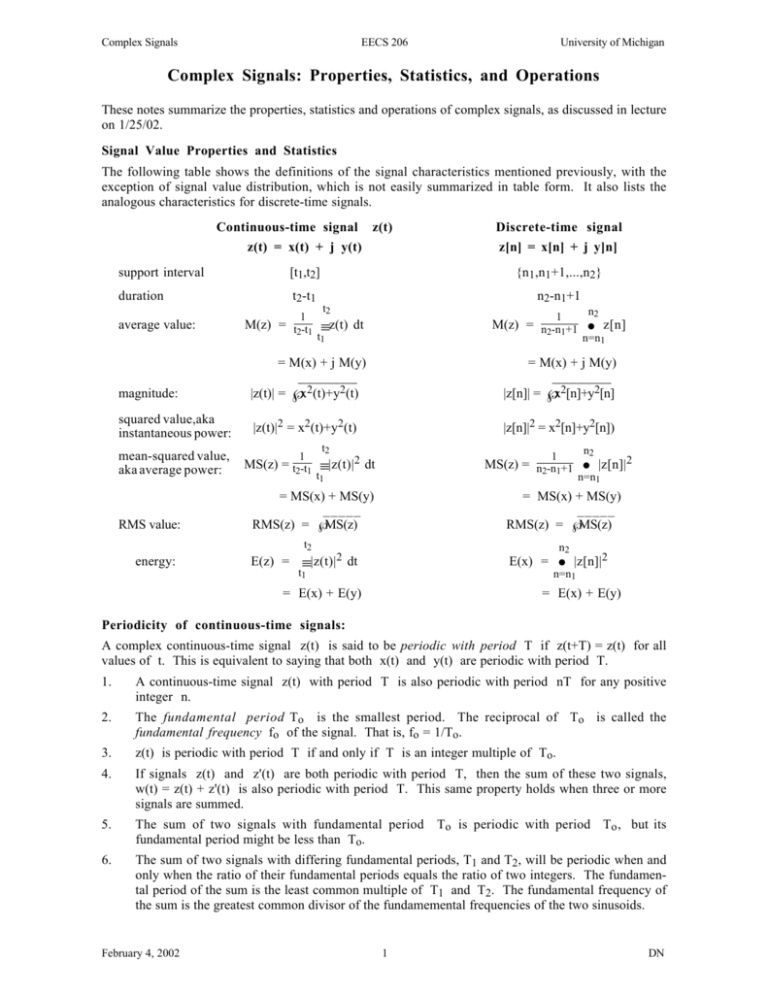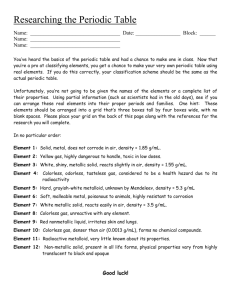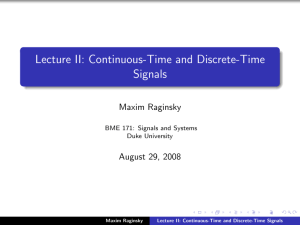Complex Signals: Properties, Statistics, and Operations t2
advertisement

Complex Signals
EECS 206
University of Michigan
Complex Signals: Properties, Statistics, and Operations
These notes summarize the properties, statistics and operations of complex signals, as discussed in lecture
on 1/25/02.
Signal Value Properties and Statistics
The following table shows the definitions of the signal characteristics mentioned previously, with the
exception of signal value distribution, which is not easily summarized in table form. It also lists the
analogous characteristics for discrete-time signals.
Continuous-time signal z(t)
z(t) = x(t) + j y(t)
Discrete-time signal
z[n] = x[n] + j y]n]
support interval
[t1,t2]
{n1,n1+1,...,n2}
duration
t2-t1
average value:
1
M(z) = t2-t1
n2-n1+1
t2
1
∫ z(t) dt
M(z) = n2-n1+1
t1
= M(x) + j M(y)
n2
∑ z[n]
n=n1
= M(x) + j M(y)
magnitude:
|z(t)| = √
x2(t)+y2(t)
|z[n]| =
x2[n]+y2[n]
√
squared value,aka
instantaneous power:
|z(t)|2 = x2(t)+y2(t)
|z[n]|2 = x2[n]+y2[n])
mean-squared value,
aka average power:
1
MS(z) = t2-t1
t2
MS(z) = n2-n1+1
1
= MS(x) + MS(y)
RMS value:
MS(z)
RMS(z) = √
E(z) =
∑ |z[n]|2
n=n1
= MS(x) + MS(y)
RMS(z) = √
MS(z)
t2
energy:
n2
1
∫ |z(t)|2 dt
t
n2
∫ |z(t)|2 dt
E(x) =
t1
∑ |z[n]|2
n=n1
= E(x) + E(y)
= E(x) + E(y)
Periodicity of continuous-time signals:
A complex continuous-time signal z(t) is said to be periodic with period T if z(t+T) = z(t) for all
values of t. This is equivalent to saying that both x(t) and y(t) are periodic with period T.
1.
A continuous-time signal z(t) with period T is also periodic with period nT for any positive
integer n.
2.
The fundamental period To is the smallest period. The reciprocal of To is called the
fundamental frequency fo of the signal. That is, fo = 1/To.
3.
z(t) is periodic with period T if and only if T is an integer multiple of To.
If signals z(t) and z'(t) are both periodic with period T, then the sum of these two signals,
w(t) = z(t) + z'(t) is also periodic with period T. This same property holds when three or more
signals are summed.
4.
5.
The sum of two signals with fundamental period To is periodic with period To , but its
fundamental period might be less than To.
6.
The sum of two signals with differing fundamental periods, T1 and T2, will be periodic when and
only when the ratio of their fundamental periods equals the ratio of two integers. The fundamental period of the sum is the least common multiple of T1 and T2. The fundamental frequency of
the sum is the greatest common divisor of the fundamemental frequencies of the two sinusoids.
February 4, 2002
1
DN
Complex Signals
EECS 206
University of Michigan
Periodicity of discrete-time signals:
A discrete-time signal z[n] is said to be periodic with period N if z[n+N] = z[n] for all integers n.
This is equivalent to saying that both x[n] and y[n] are periodic with period N.
1.
A discrete-time signal with period N is also periodic with period mN for any positive integer
m.
2.
The fundamental period, denoted No, is the smallest period. The reciprocal of No is called the
fundamental frequency fo of the signal. That is, fo = 1/No.
3.
z[n] is periodic with period N if and only if N is an integer multiple of No.
4.
If signals z[n] and z'[n] are both periodic with period N, then the sum of these two signals,
w[n] = z[n] + z'[n] is also periodic with period N. This same property holds when three or more
signals are summed.
5.
The sum of two signals with fundamental period No is periodic with period No , but its
fundamental period might be less than No.
6.
The sum of two signals with differing fundamental periods, N1 and N2, is periodic with fundamental period equal to the least common multiple of N1 and N2 and fundamental frequency
equal to the greatest common divisor of their fundamental frequencies f1 and f2 . Note that
unlike continuous-time case, the ratio of the fundamental periods of discrete-time periodic signals
is always the ratio of two integers. Therefore, the sum is always periodic.
A.
Elementary Operations on One Signal.
These are illustrated for continuous-time signals, but apply equally to discrete-time signals.
Adding a constant: z'(t) = z(t) + c , where c is a real or complex number.
Amplitude scaling: z'(t) = c z(t) , where c is a real or complex number.
This has the effect of scaling both the average and the mean-squared values. Specifically, M(z') =
c M(z) and MS(z') = |c|2 MS(z).
Time shifting: If z(t) is a signal and T is some number, then the signal
z'(t) = z(t-T) = x(t-T) + j y(t-T)
is a time-shifted version of x(t).
Time reflection/reversal: The time reflected or time reversed version of a signal z(t) is
z'(t) = z(-t).
Time scaling: The operation of time-scaling a signal x(t) produces a signal
z'(t) = z(ct)
where c is some positive real-valued constant.
Combinations of the above operations: In the future we will frequently encounter signals
obtained by combining several of the operations introduced above, for example,
z'(t) = 3 z(-2(t-1)) .
February 4, 2002
2
DN
Complex Signals
B.
EECS 206
University of Michigan
Elementary Operations on Two or More Signals
These are illustrated for continuous-time signals, but apply equally to discrete-time signals.
Summing: w(t) = z(t) + z'(t) .
Linear combining: w(t) = c1 z1 (t) + c2 z2 (t) + c3 z3 (t) , where c1 ,c2 ,c3 are real or complex
numbers.
Multiplying: w(t) = z(t) z(t) .
Concatenating: Concatenation is the process of appending one signal to the end of another.
C.
Correlation
The correlation between continuous-time complex signals z(t) and z'(t) is
t2
C(z,z') =
∫ z(t) z'* (t) dt ,
t1
where (t1,t2) is the time interval of interest.
Similarly, the correlation between discrete-time complex signals z[n] and z'[n] is defined to be
n2
C(z,z') =
∑ z[n] z'*[n] .
n1
The correlation between a signal and itself is the signals energy:
C(z,z) = E(x) .
Correlation is not symmetric, i.e. C(z,z') ≠ C(z',z). However,
C(z',z) = C*(z,z') .
The normalized correlation between signals z and z' is
C(z,z')
.
C N (z,z') =
E(z)√
E(z')
√
Schwarz Inequality
|CN (z,z')| ≤ 1,
with equality if and only if one signal is an amplitude scaling of the other; i.e. y(t) = c x(t) for
some real or complex constant c.
February 4, 2002
3
DN







